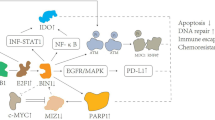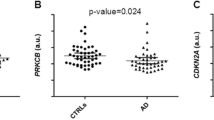Abstract
PICALM (phosphatidylinositol-binding clathrin assembly protein) mutations have been linked to a number of human disorders, including leukemia, Alzheimer’s disease, and Parkinson’s disease. Nevertheless, the effect of PICALM on cancer, particularly on prognosis and immune infiltration in individuals with BRCA, is unknown. We obtained the data of breast cancer patients from The Cancer Genome Atlas (TCGA) database, and analyzed the expression of PICALM in breast cancer, its impact on survival’ and its role in tumor immune invasion. Finally, in vitro cellular experiments were performed to validate the results. Research has found that PICALM expression was shown to be downregulated in BRCA and to be substantially linked with clinical stage, histological type, PAM50, and age. PICALM downregulation was linked to a lower overall survival (OS) and disease-specific survival (DSS) in BRCA patients. A multivariate Cox analysis revealed that PICALM is an independent predictor of OS. The enriched pathways revealed by functional enrichment analysis included oxidative phosphorylation, angiogenesis, the TGF signaling pathway, and the IL-6/JAK/STAT3 signaling system. Furthermore, the amount of immune cell infiltration by B cells, eosinophils, mast cells, neutrophils, and T cells was positively linked with PICALM expression. Finally, we experimentally verified that low expression of PICALM can reduce proliferation, migration, and invasion in tumor cells. This evidence shows that PICALM expression impacts prognosis, immune infiltration, and pathway expression in breast cancer patients, and it might be a potential predictive biomarker for the disease.







Similar content being viewed by others
Data Availability
The datasets used and analyzed during the current study are available from the corresponding author upon reasonable request.
References
Sung, H., Ferlay, J., Siegel, R. L., et al. (2021). Global cancer statistics 2020: GLOBOCAN estimates of incidence and mortality worldwide for 36 cancers in 185 countries. CA: a Cancer Journal for Clinicians, 71(3), 209–249.
Siegel, R. L., Miller, K. D., & Jemal, A. (2019). Cancer statistics, 2019. CA: a Cancer Journal for Clinicians, 69(1), 7–34.
Zuo, Y., Li, Y., Zhou, Z., et al. (2017). Long non-coding RNA MALAT1 promotes proliferation and invasion via targeting miR-129-5p in triple-negative breast cancer. Biomedicine & Pharmacotherapy, 95, 922–928.
Hassan, M. K., Kumar, D., Naik, M., et al. (2018). The expression profile and prognostic significance of eukaryotic translation elongation factors in different cancers. PLoS One, 13(1), e0191377.
Xu, J., Liu, L., Ma, R., et al. (2021). E2F1 Induces KIF26A transcription and promotes cell cycle progression via CDK-RB-E2Fs feedback loop in breast cancer. Frontiers in Oncology, 10, 530933.
Liu, H., Qiu, C., Wang, B., et al. (2021). Evaluating DNA methylation, gene expression, somatic mutation, and their combinations in inferring tumor tissue-of-origin. Frontiers in Cell and Development Biology, 9, 619330.
Hunter, N. B., Kilgore, M. R., & Davidson, N. E. (2020). The long and winding road for breast cancer biomarkers to reach clinical utility. Clinical Cancer Research, 26(21), 5543–5545.
Zhang, Y., Xiang, J., Tang, L., et al. (2021). Identifying breast cancer-related genes based on a novel computational framework involving KEGG pathways and PPI network modularity. Frontiers in Genetics, 12, 596794.
Dreyling, M. H., Martinez-Climent, J. A., Zheng, M., et al. (1996). The t(10;11)(p13;q14) in the U937 cell line results in the fusion of the AF10 gene and CALM, encoding a new member of the AP-3 clathrin assembly protein family. Proceedings of the National Academy of Sciences of the United States of America, 93(10), 4804–4809.
Tebar, F., Bohlander, S. K., & Sorkin, A. (1999). Clathrin assembly lymphoid myeloid leukemia (CALM) protein: Localization in endocytic-coated pits, interactions with clathrin, and the impact of overexpression on clathrin-mediated traffic. Molecular Biology of the Cell, 10(8), 2687–2702.
Caudell, D., & Aplan, P. D. (2008). The role of CALM-AF10 gene fusion in acute leukemia. Leukemia, 22(4), 678–685.
Meyerholz, A., Hinrichsen, L., Groos, S., et al. (2005). Effect of clathrin assembly lymphoid myeloid leukemia protein depletion on clathrin coat formation. Traffic, 6(12), 1225–1234.
Scotland, P. B., Heath, J. L., Conway, A. E., et al. (2012). The PICALM protein plays a key role in iron homeostasis and cell proliferation. PLoS One, 7(8), e44252.
Suzuki, M., Tanaka, H., Tanimura, A., et al. (2012). The clathrin assembly protein PICALM is required for erythroid maturation and transferrin internalization in mice. PLoS One, 7(2), e31854.
Narayan, P., Sienski, G., Bonner, J. M., et al. (2020). PICALM rescues endocytic defects caused by the Alzheimer’s disease risk factor APOE4. Cell Reports, 33(1), 108224.
Periñán, M. T., Macías-García, D., Labrador-Espinosa, M. Á., et al. (2021). Association of PICALM with cognitive impairment in Parkinson’s disease. Movement Disorders, 36(1), 118–123.
Xu, W., Tan, L., & Yu, J. T. (2015). The role of PICALM in Alzheimer’s disease. Molecular Neurobiology, 52(1), 399–413.
Borel, C., Dastugue, N., Cances-Lauwers, V., et al. (2012). PICALM-MLLT10 acute myeloid leukemia: A French cohort of 18 patients. Leukemia Research, 36(11), 1365–1369.
Tang, Z., Kang, B., Li, C., et al. (2019). GEPIA2: An enhanced web server for large-scale expression profiling and interactive analysis. Nucleic Acids Research, 47(W1), W556–W560.
Uhlen, M., Zhang, C., Lee, S., et al. (2017). A pathology atlas of the human cancer transcriptome. Science., 357(6352), eaan2507.
Love, M. I., Huber, W., & Anders, S. (2014). Moderated estimation of fold change and dispersion for RNA-seq data with DESeq2. Genome Biology, 15(12), 550.
Zhou, Y., Zhou, B., Pache, L., et al. (2019). Metascape provides a biologist-oriented resource for the analysis of systems-level datasets. Nature Communications, 10(1), 1523.
Yu, G., Wang, L. G., Han, Y., et al. (2012). clusterProfiler: An R package for comparing biological themes among gene clusters. OMICS, 16(5), 284–287.
Bindea, G., Mlecnik, B., Tosolini, M., et al. (2013). Spatiotemporal dynamics of intratumoral immune cells reveal the immune landscape in human cancer. Immunity, 39(4), 782–795.
Mayank, J. V. (2014). Drug target strategies in breast cancer treatment: Recent developments. Anti-Cancer Agents in Medicinal Chemistry, 14(10), 1414–1427.
Maruthanila, V. L., Elancheran, R., Kunnumakkara, A. B., et al. (2017). Recent development of targeted approaches for the treatment of breast cancer. Breast Cancer, 24(2), 191–219.
Sun, C. C., Li, S. J., Hu, W., et al. (2022). Retraction notice to: Comprehensive analysis of the expression and prognosis for E2Fs in human breast cancer. Molecular Therapy, 30(7), 2639.
Huang, F., Khvorova, A., Marshall, W., & Sorkin, A. (2004). Analysis of clathrin-mediated endocytosis of epidermal growth factor receptor by RNA interference. The Journal of Biological Chemistry, 279(16), 16657–16661.
Bohlander, S. K., Muschinsky, V., Schrader, K., et al. (2000). Molecular analysis of the CALM/AF10 fusion: Identical rearrangements in acute myeloid leukemia, acute lymphoblastic leukemia and malignant lymphoma patients. Leukemia, 14(1), 93–99.
Abdelhaleem, M., Beimnet, K., Kirby-Allen, M., et al. (2007). High incidence of CALM-AF10 fusion and the identification of a novel fusion transcript in acute megakaryoblastic leukemia in children without Down’s syndrome. Leukemia, 21(2), 352–353.
Jiang, L., Ren, L., Zhang, X., et al. (2019). Overexpression of PIMREG promotes breast cancer aggressiveness via constitutive activation of NF-κB signaling. EBioMedicine, 43, 188–200.
Li, T., Kang, G., Wang, T., et al. (2018). Tumor angiogenesis and anti-angiogenic gene therapy for cancer. Oncology Letters, 16(1), 687–702.
Ying, L., Chen, Q., Wang, Y., et al. (2012). Upregulated MALAT-1 contributes to bladder cancer cell migration by inducing epithelial-to-mesenchymal transition. Molecular BioSystems, 8(9), 2289–2294.
Kuol, N., Stojanovska, L., Apostolopoulos, V., et al. (2018). Role of the nervous system in tumor angiogenesis. Cancer Microenvironment, 11(1), 1–11.
Roskoski, R., Jr. (2007). Vascular endothelial growth factor (VEGF) signaling in tumor progression. Critical Reviews in Oncology/Hematology, 62(3), 179–213.
Garcea, G., Lloyd, T. D., Gescher, A., et al. (2004). Angiogenesis of gastrointestinal tumours and their metastases--A target for intervention? European Journal of Cancer, 40(9), 1302–1313.
Syed, V. (2016). TGF-β Signaling in Cancer. Journal of Cellular Biochemistry, 117(6), 1279–1287.
Tang, X., Shi, L., Xie, N., et al. (2017). SIRT7 antagonizes TGF-β signaling and inhibits breast cancer metastasis. Nature Communications, 8(1), 318.
Cao, W. H., Liu, X. P., Meng, S. L., et al. (2016). USP4 promotes invasion of breast cancer cells via Relaxin/TGF-β1/Smad2/MMP-9 signal. European Review for Medical and Pharmacological Sciences, 20(6), 1115–1122.
Li, B., Severson, E., Pignon, J. C., et al. (2016). Comprehensive analyses of tumor immunity: Implications for cancer immunotherapy. Genome Biology, 17(1), 174.
Liu, J., Tan, Z., He, J., et al. (2020). Identification of three molecular subtypes based on immune infiltration in ovarian cancer and its prognostic value. Bioscience Reports, 40(10), BSR20201431.
Havel, J. J., Chowell, D., & Chan, T. A. (2019). The evolving landscape of biomarkers for checkpoint inhibitor immunotherapy. Nature Reviews. Cancer, 19(3), 133–150.
Wang, S. S., Liu, W., Ly, D., et al. (2019). Tumor-infiltrating B cells: Their role and application in anti-tumor immunity in lung cancer. Cellular & Molecular Immunology, 16(1), 6–18.
Yang, C., Lee, H., Jove, V., et al. (2013). Prognostic significance of B-cells and pSTAT3 in patients with ovarian cancer. PLoS One, 8(1), e54029.
Komi, D. E. A., & Redegeld, F. A. (2020). Role of mast cells in shaping the tumor microenvironment. Clinical Reviews in Allergy and Immunology, 58(3), 313–325.
Sammarco, G., Varricchi, G., Ferraro, V., et al. (2019). Mast cells, angiogenesis and lymphangiogenesis in human gastric cancer. International Journal of Molecular Sciences, 20(9), 2106.
Reddy, S. M., Reuben, A., Barua, S., et al. (2019). Poor response to neoadjuvant chemotherapy correlates with mast cell infiltration in inflammatory breast cancer. Cancer Immunology Research, 7(6), 1025–1035.
Acknowledgements
We thank the TCGA database for sharing a large amount of data and the convenience provided by several online database tools. At the same time, thank you to Baidu Translate and DeepL for providing free translation and polishing.
Author information
Authors and Affiliations
Contributions
All authors contributed to the study’s conception and design. All authors read and approved the final manuscript. All authors commented on previous versions of the manuscript. All authors agree to become authors of the manuscript.
Corresponding author
Ethics declarations
Ethics Approval and Consent to Participate
Not applicable
Consent for Publication
All authors consent to the publication of this work.
Competing Interests
The authors declare no competing interests.
Additional information
Publisher’s Note
Springer Nature remains neutral with regard to jurisdictional claims in published maps and institutional affiliations.
Rights and permissions
Springer Nature or its licensor (e.g. a society or other partner) holds exclusive rights to this article under a publishing agreement with the author(s) or other rightsholder(s); author self-archiving of the accepted manuscript version of this article is solely governed by the terms of such publishing agreement and applicable law.
About this article
Cite this article
A, N., Lyu, P., Yu, Y. et al. PICALM as a Novel Prognostic Biomarker and Its Correlation with Immune Infiltration in Breast Cancer. Appl Biochem Biotechnol (2024). https://doi.org/10.1007/s12010-023-04840-z
Accepted:
Published:
DOI: https://doi.org/10.1007/s12010-023-04840-z




